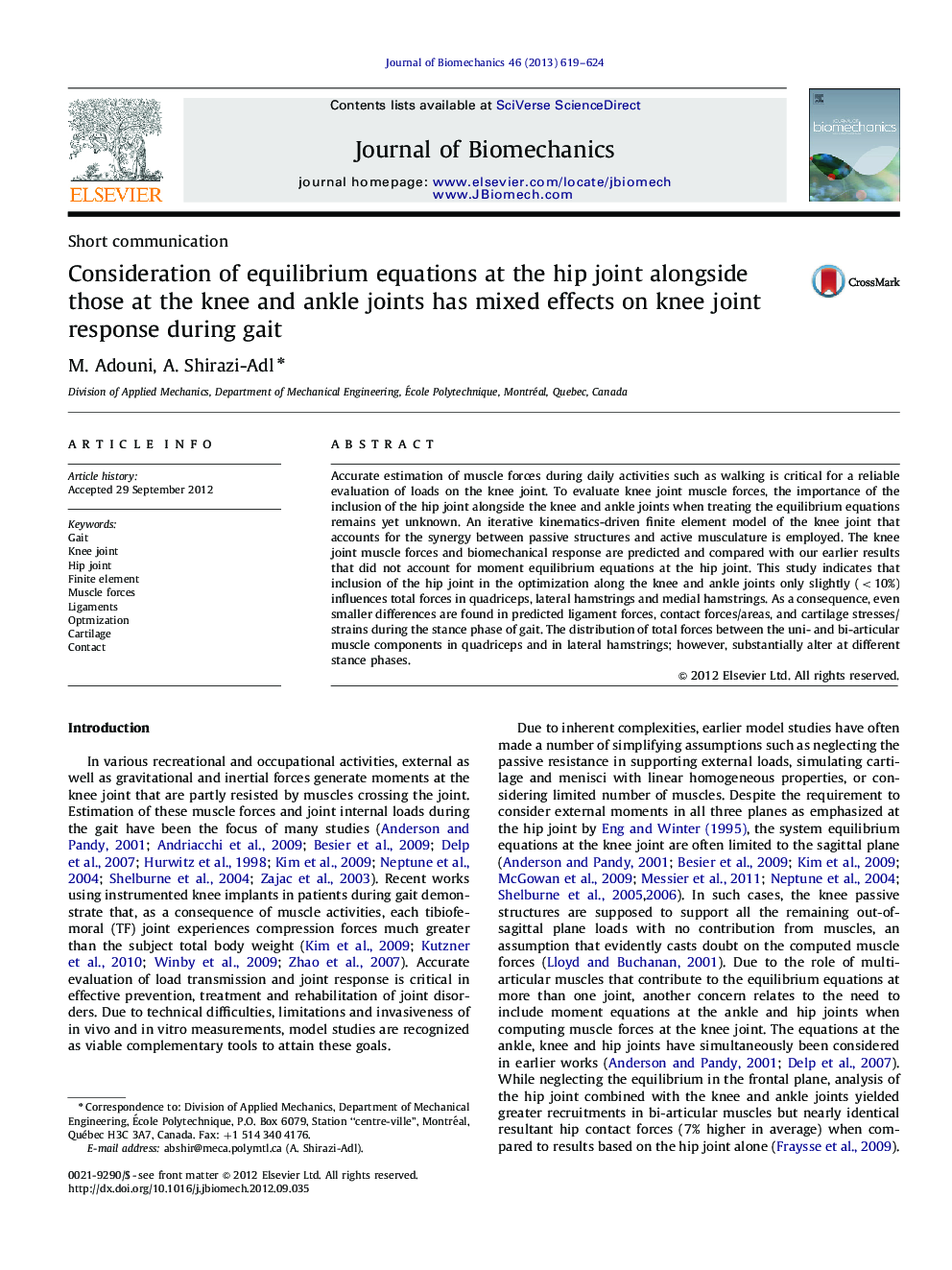| کد مقاله | کد نشریه | سال انتشار | مقاله انگلیسی | نسخه تمام متن |
|---|---|---|---|---|
| 10431992 | 910232 | 2013 | 6 صفحه PDF | دانلود رایگان |
عنوان انگلیسی مقاله ISI
Consideration of equilibrium equations at the hip joint alongside those at the knee and ankle joints has mixed effects on knee joint response during gait
ترجمه فارسی عنوان
در نظر گرفتن معادلات تعادل در مفصل ران همراه با آنهایی که در مفصل زانو و مچ پا قرار دارند اثر متفاوتی روی واکنش مشترک زانو در طی راه رفتن دارد
دانلود مقاله + سفارش ترجمه
دانلود مقاله ISI انگلیسی
رایگان برای ایرانیان
کلمات کلیدی
راه رفتن، مفصل زانو، مفصل ران، المان محدود، نیروهای عضلانی، مصلحت، برداشتن غضروف، تماس،
ترجمه چکیده
برآورد دقیق نیروهای عضلانی در فعالیت های روزمره مانند پیاده روی برای بررسی قابل اعتماد بار در مفصل زانو بسیار مهم است. برای ارزیابی نیروهای عضلانی مفصل زانو، اهمیت ورود مجدد مفصل ران در کنار مفصل زانو و مچ پا در هنگام معاینه تعادل هنوز مشخص نیست. یک مدل عنصر محدود از جنبش تکراری متحرک مفصل زانو که منجر به ایجاد همبستگی بین ساختارهای غیر فعال و عضلات فعال می شود، مورد استفاده قرار می گیرد. نیروی عضلانی جناغ زانو و پاسخ بیومکانیک پیش بینی شده و با نتایج قبلی ما مقایسه شده است که معادلات تعادل لحظه ای در مفصل ران را در نظر نگرفتند. این مطالعه نشان می دهد که ترکیب مفصل مفصل ران در بهینه سازی در طول مفصل زانو و مچ پا تنها کمی (<10٪) بر نیروهای کلیدی در چهارگوشه، همسترینگ جانبی و همسترینگ مدیال تاثیر می گذارد. به عنوان یک نتیجه، حتی تفاوت های کوچکتر در نیروهای لجن پیش بینی شده، نیروها / مناطق تماس، و استرس / غده های غضروف در طول مرحله ایست راه رفتن پیدا شده است. توزیع نیروهای کلیدی بین اجزای عضلانی دو طرفه و دو طرفه در چهارگوشه و در همسترینگ های جانبی؛ با این حال، در مرحله های مختلف ایستاده تغییر می کند.
موضوعات مرتبط
مهندسی و علوم پایه
سایر رشته های مهندسی
مهندسی پزشکی
چکیده انگلیسی
Accurate estimation of muscle forces during daily activities such as walking is critical for a reliable evaluation of loads on the knee joint. To evaluate knee joint muscle forces, the importance of the inclusion of the hip joint alongside the knee and ankle joints when treating the equilibrium equations remains yet unknown. An iterative kinematics-driven finite element model of the knee joint that accounts for the synergy between passive structures and active musculature is employed. The knee joint muscle forces and biomechanical response are predicted and compared with our earlier results that did not account for moment equilibrium equations at the hip joint. This study indicates that inclusion of the hip joint in the optimization along the knee and ankle joints only slightly (<10%) influences total forces in quadriceps, lateral hamstrings and medial hamstrings. As a consequence, even smaller differences are found in predicted ligament forces, contact forces/areas, and cartilage stresses/strains during the stance phase of gait. The distribution of total forces between the uni- and bi-articular muscle components in quadriceps and in lateral hamstrings; however, substantially alter at different stance phases.
ناشر
Database: Elsevier - ScienceDirect (ساینس دایرکت)
Journal: Journal of Biomechanics - Volume 46, Issue 3, 1 February 2013, Pages 619-624
Journal: Journal of Biomechanics - Volume 46, Issue 3, 1 February 2013, Pages 619-624
نویسندگان
M. Adouni, A. Shirazi-Adl,
